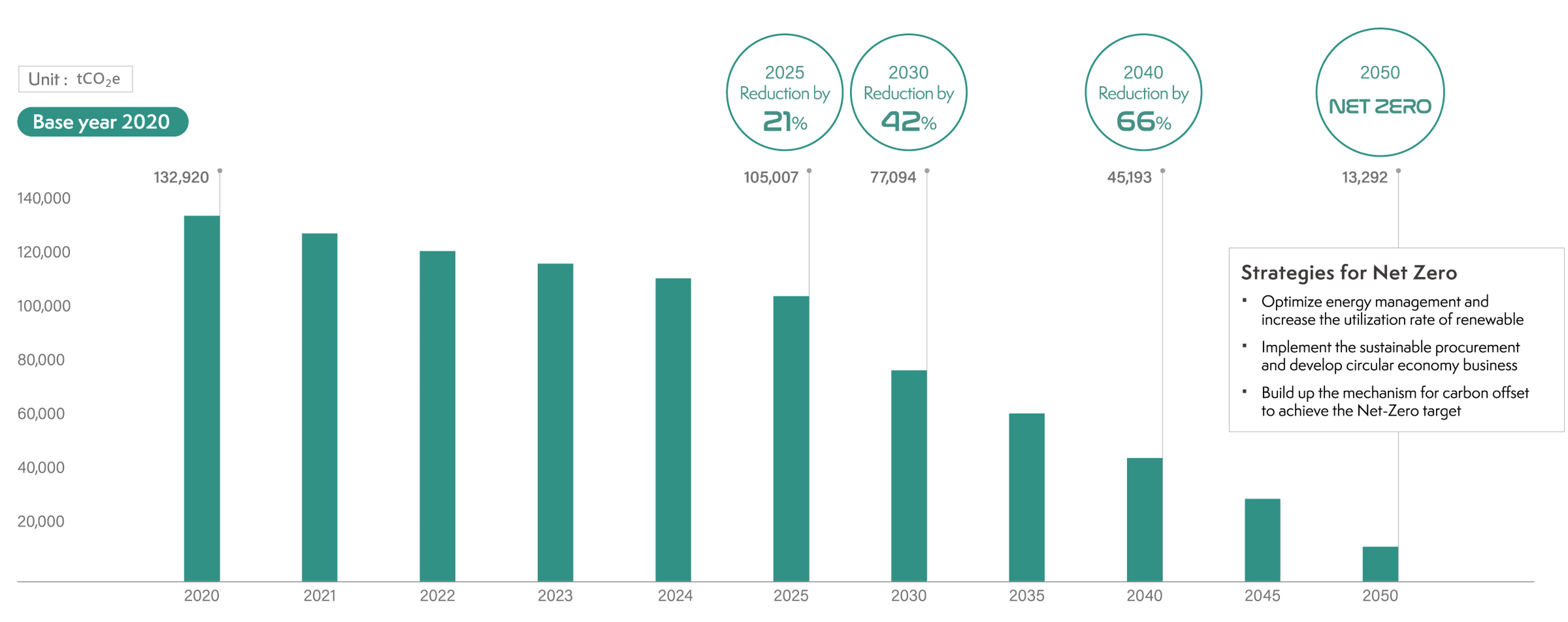Climate Action


Climate Commitments and Actions
Inventec is proactively addressing the challenges of global climate change, with Science Based Targets (SBTs) as its core guiding principle. The Company has set a decarbonization pathway with 2020 as the baseline year and is progressively moving towards the goal of net-zero emissions by following the Net-Zero Science Based Targets (Net-Zero SBT) framework. To achieve this goal, Inventec actively carries out multiple carbon reduction initiatives and works hand-in-hand with global partners to collectively strive to limit the global temperature increase to within 1.5°C, fulfilling its social responsibility as a corporate citizen.
Inventec SBT carbon reduction target
Under the WB2C (Well Below 1.5°C) scenario, the goal to be achieved for absolute carbon reduction by 2030.
Scope 1 and 2: GHG emissions reduced by 42%

In 2024, total Scope 1 and 2 carbon emissions(market-based) were 95,294.4923 tCO2eNote 1, 28.31% lower than the 2020 baseline year, 13.83% lower than the 2024 reduction target of 110,589.8115 tCO2eNote 2.
- Note 1: Carbon emission offset through the purchase of renewable energy and international renewable energy certificates amounted to 38,219.1821 tCO2e.
- Note 2: The GHG inventory boundary covers Inventec's parent company and all consolidated subsidiaries, totaling 50 companies.
Value Chain GHG Emission Management
Since 2008, Inventec has conducted greenhouse gas inventory assessments continuously for 16 years. To ensure stakeholder acceptance of these assessments, the process and documentation adhere to regulations such as the Executive Yuan Ministry of Environment’s Greenhouse Gas Emissions Inventory Registration and Management Regulations, as well as international standards such as ISO 14064-1. These efforts are verified by third-party audits. Furthermore, to expand the scope of inventory assessments and enhance data analysis efficiency, Inventec utilizes a carbon management platform for digital inventory assessments. This approach enables real-time and efficient management of greenhouse gas emissions data. In 2024, Inventec further optimized the iSupplier platform and continued to drive supplier participation in GHG emissions surveys. These surveys covered 649 suppliers from the Personal Solution Group and the Enterprise Business group. Looking ahead, Inventec plans to establish a Digital Supply Chain Academy Platform, with the goal of continuously enhancing suppliers' capabilities in GHG inventory and management. By leveraging its influence, Inventec is committed to working hand in hand with its suppliers to advance towards the shared goal of net-zero carbon emissions, thereby realizing a cooperative vision where larger enterprises support and uplift smaller partners in the supply chain.
Greenhouse Gas Emissions
Scope 1 and 2 Emissions Intensity
Scope 3 Emissions
| category | 2021 | 2022 | 2023 | 2024 |
|---|---|---|---|---|
| Purchased goods and services | 195,876 | 170,931 | 129,928 | 3,158,975 |
| Capital goods | - | - | - | - |
| Fuel and energy related activities | - | - | - | - |
| Upstream transportation and distribution | 2,029 | 1,373 | 627 | 565 |
| Waste generated in operations | 2,159 | 1,664 | 1,381 | 952 |
| Business travel | 226 | 262 | 2,004 | 2,652 |
| Employee commuting | 2,636 | 2,732 | 2,290 | 2,268 |
| Upstream leased assets | - | - | - | - |
| Downstream transportation and distribution | 55,991 | 119,986 | 36,964 | 44,328 |
| Processing of sold products and services | - | - | - | - |
| Use of sold products and services | 364,671 | 543,288 | 666,546 | 3,570,074 |
| End-of-life treatment of sold products and services | - | - | - | - |
| Downstream leased assets | 4,249 | 5,097 | 4,754 | 4,278 |
| Franchises | - | - | - | - |
| Investments | 36,611 | 33,885 | - | - |
- 「-」represents N/A for Inventec. In 2023, independent inventory was conducted for five key production sites of its subsidiary, Inventec Appliances, hence "Investments" are marked as not applicable.
Energy Usage
Renewable Energy Usage
Energy Saving and Carbon Reduction Achievements
Inventec's climate mitigation measures are focused on “energy conservation”and“promoting renewable energy”. Inventec also has dedicated units in each factory, such as factory management team, to set annual energy-saving targets and implement diverse carbon reduction plans. Additionally, Inventec has established the mechanism for regular reporting to sustainable environment team to facilitate experience sharing among factories. This approach ensures that we effectively monitor short, medium, and long-term carbon reduction results and progress, which are reported to the Sustainability Committee and Board of Directors.
Energy Conservation
- Replace with low-carbon, energy-saving equipment such as lighting fixtures and natural gas boilers.
- Install or upgrade equipment with inverter functions such as air compressors, cooling water pumps, and fans.
- Minimize the energy consumption of humidifiers.
- Continuously adjust the equipment configuration, such as the number of power-consuming equipment like air compressors and chillers, based on the production schedule for each production line.
- Install time-controlled switches according to seasonal changes, such as road lights and factory neon lights of regional lighting equipment .
- Adjust the frequency of use for energy-consuming equipment, air conditioning systems, etc.
- Retrofit air compressors for heat recovery.
- Regularly adding chemicals, cleaning, and replacing components to enhance heat exchange and air supply efficiency, such as plate heat exchangers, cooling water towers, and filter bags.
- Maximize the use of external fresh air, such as air conditioning in fall and winter.
2024 Energy-Saving Results
Promotion of Renewable Energy
- Establishing in-house renewable energy power station
- Solar power station
- Adopting diversified renewable energy solutions
- Purchase renewable energy electricity
- Purchase renewable energy certificates

